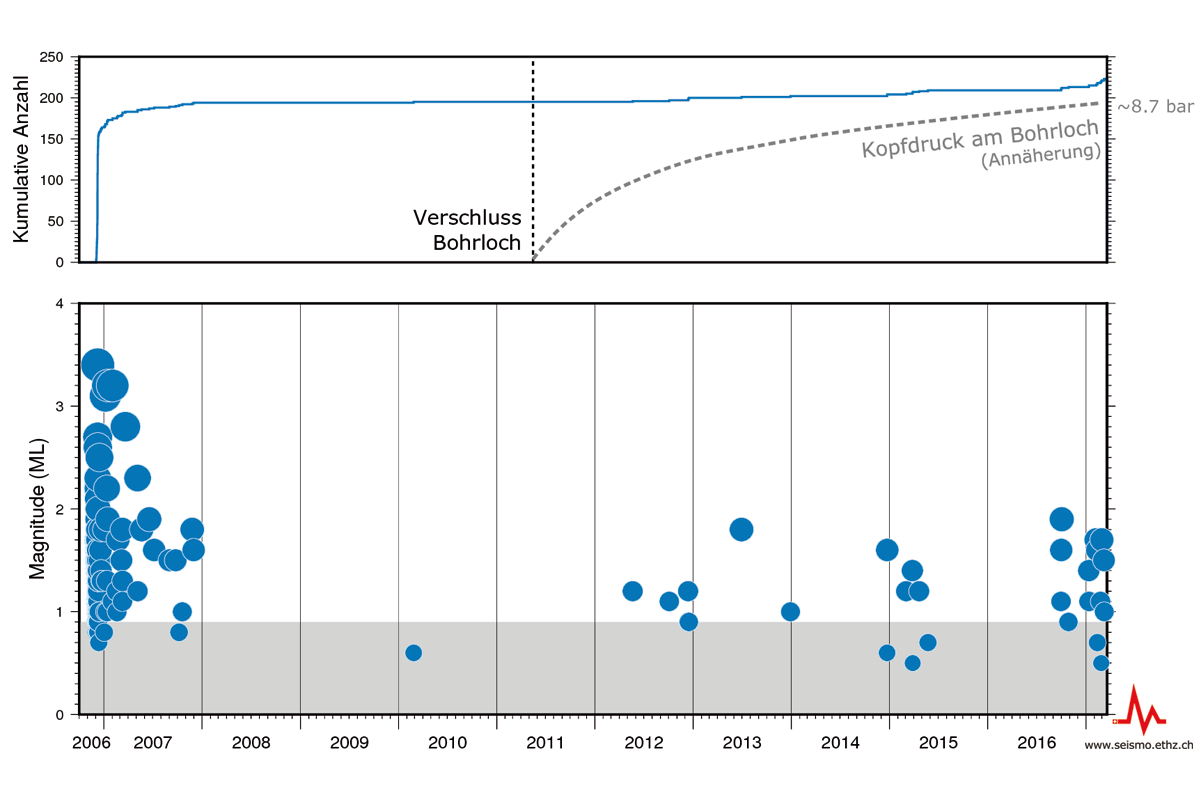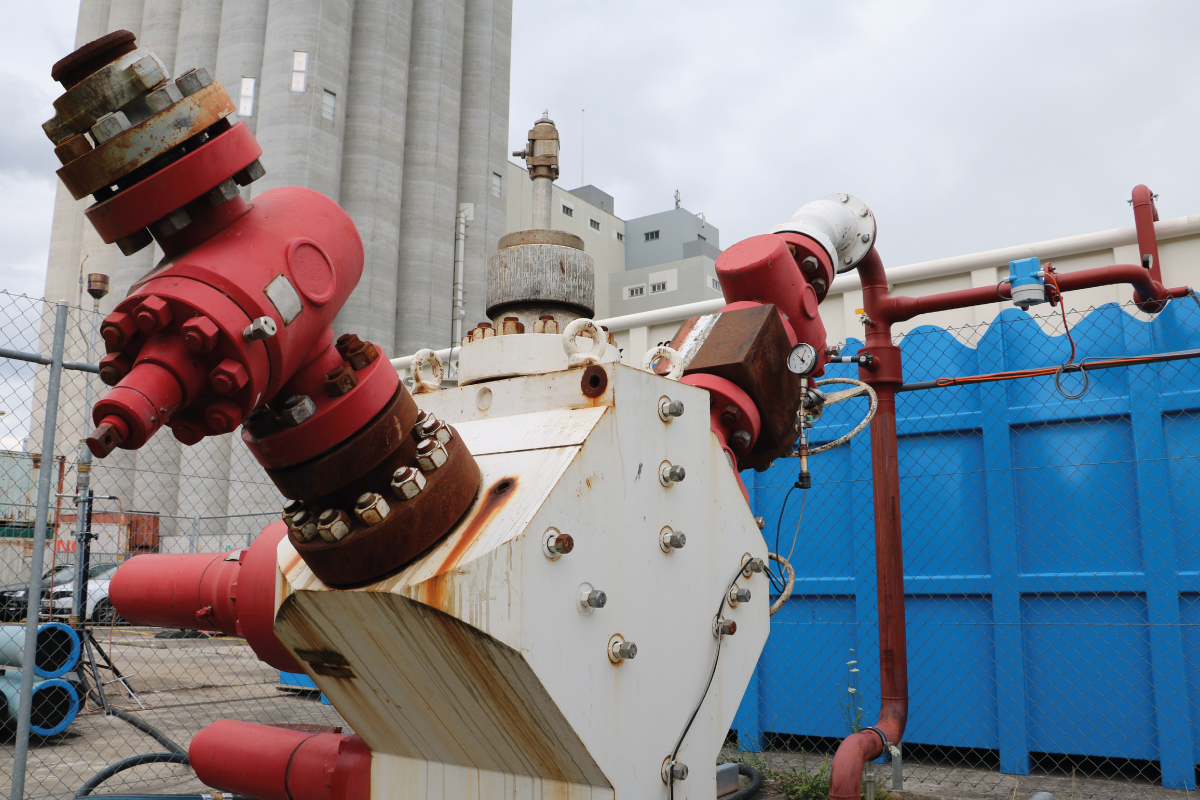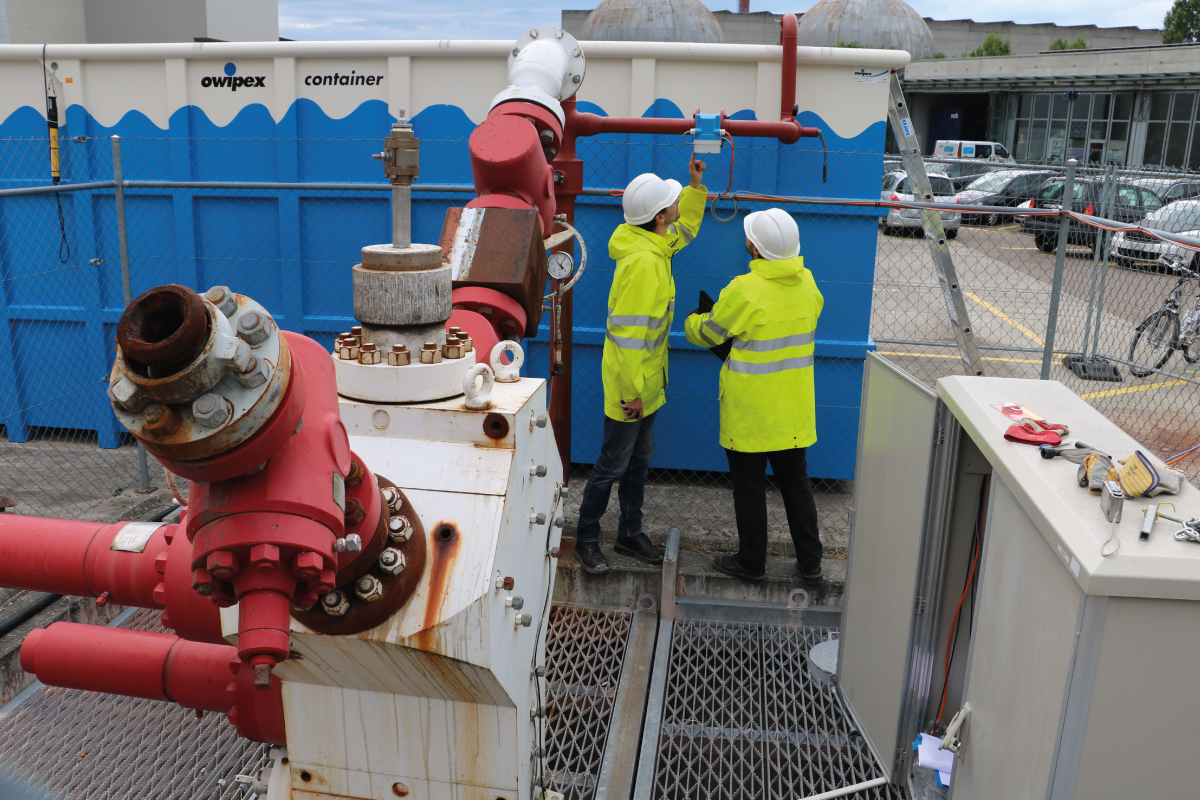Project description geothermal energy Basel
The Deep Heat Mining Project in Basel was a ground-breaking Swiss energy research project that planned to build a pilot plant for a geothermal power station using the Enhanced Geothermal System (EGS) or 'petrothermal energy generation'. This entails forcing a cold liquid, usually water, down into hot rock, where it heats up before being conveyed back up to the surface to be used to generate heat or electricity.
In the medium term, the project was intended to generate environmentally-friendly power, harnessing Swiss energy sources and lowering the country's reliance on imported electricity. A pilot plant, due to be built in Basel, was supposed to generate 6 MW of electricity and 17 MW of heat, whilst emitting hardly any CO2 and barely producing any waste. This output would have sufficed to meet the energy needs of around 10,000 households and the heating requirements of 2,700 homes. The plan was to drill to a depth of 5,000 metres to exploit the temperatures of 200°C there.
The intended site of the future geothermal power plant was the Basel Industrial Works (IWB) site in Basel-Kleinhüningen. From there, the heat could have been injected into the extensively developed municipal district heating system. During the summer months, when there is low demand for district heating, the plant would mainly have generated power.
The first geothermal project in Switzerland designed to generate electricity was launched in Basel. In December 2006, after an exploratory phase, water was due to be forced under high pressure into the crystalline basement rock over a two-week period. The aim of this procedure was to increase its permeability at a depth of between 4,000 and 5,000 m and create a geothermal reservoir where the liquid would circulate and heat up.
The geothermal injection process was tracked by a dense network of seismic monitoring stations, including six of the borehole seismometers operated by Geopower Basel AG at depths of between 300 and 2,700 m. As anticipated, these stations recorded thousands of microquakes. The SED runs a compact network of seismic stations in the Basel area, which was substantially densified during the Deep Heat Mining Project. In addition to this, the federal state of Baden-Württemberg's Earthquake Office (LED) set up a number of monitoring stations on the German side of the border with Switzerland. The SED had access to the data generated by these stations and was tasked to estimate the magnitude of the detected earthquakes.
The rate of injection (quantity of liquid over time) was gradually increased until, on the sixth day, the maximum rate was reached. Shortly after, an earthquake with a local magnitude of 2.6 occurred, whereupon the rate of injection was first decreased and then stopped altogether a few hours later. Approximately five hours after that, an earthquake with a local magnitude of 3.4 (moment magnitude 3.1) occurred. Having an intensity of V ("moderate" on the Mercalli scale), it was felt over a wide area and caused minor damage. Three more quakes with local magnitudes of higher than 3.0 ensued, the last occurring in February 2007. All in all, more than 200 earthquakes with magnitudes of 0.9 (ML) or above were recorded (equivalent to over 900 earthquakes with Mw). Consequently, the project managers stopped implementing their plan and definitively terminated the project in 2009 after a comprehensive risk assessment.
For the most part, the damage reported concerned small cracks in buildings' plasterwork. Most claims, which totalled CHF 6 million, resulted in the payment of compensation.

Earthquake activity in the vicinity of the borehole has been monitored by a seismic network since the start of the project. The indications from the amassed data are that seismic activity in the stimulated area has more or less continually decreased since the project ended in 2006. Roughly a year after the closure of the borehole in April 2011, seismic activity in the immediate vicinity of the borehole markedly increased again. This increase has been particularly noticeable since the second half of 2016 and typically consisted of swarms of microearthquakes, with phases of increased activity over a number of weeks being followed by quieter periods. So far, none of these earthquakes were felt by the public.
Apart from the seismic activity, in recent months the spatial distribution of the quakes has also shifted. The latest earthquakes occurred at the southern and northern edges of the previously affected area, suggesting that the artificially induced fractures are spreading. In addition, measurements show that the hydraulic pressure in the reservoir (pore pressure) has steadily increased since the borehole was closed. A detailed analysis of the seismic data and modelling of the relationship between earthquakes and increasing pore pressure have shown that even modest pressure increases in the reservoir can significantly increase seismicity.
On 28 March 2017, in consultation with Basel Industrielle Werke (IWB) the Department of Health of the Canton of Basel decided to re-open the borehole created in Basel as part of the "Deep Heat Mining" geothermal power project in 2006. An extensive scientific study by the Swiss Seismological Service (SED) at the ETH Zurich revealed that the increased earthquake activity will most probably subside again in the long term if the borehole is opened.
Right from the start of the project, the Swiss Seismological Service (SED) has been responsible for independently monitoring the seismic stimulation process. Recorded quakes have constantly been registered by a purpose-expanded seismic network, their epicentre was located by the SED and the results were published as a database and on maps on the project website. When a recorded quake has a local magnitude of 2.0 or more, the SED also informs the relevant authorities. In addition, the SED also provided the authorities of the Canton of Basel-Stadt on the implementation of the SERIANEX study [1] with expert advice on the earthquake risk of the Deep Heat Mining project. Since May 2012, the canton has commissioned the SED to take over the seismic monitoring of the immediate vicinity of the borehole in Basel from Geopower Basel. Furthermore, in March 2017 the SED drafted an analysis of induced earthquakes following the discontinuation of the geothermal energy project in Basel.
Click here for more information on the SED's role in monitoring geothermal energy projects.

